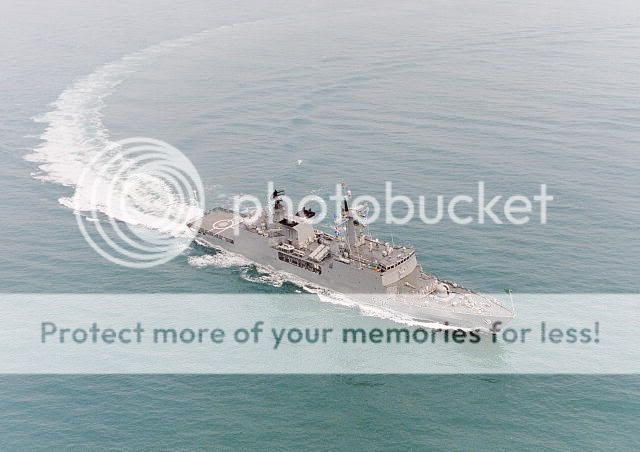Raquib
SENIOR MEMBER

- Joined
- Mar 14, 2008
- Messages
- 895
- Reaction score
- 0
BNS Khalid Bin Walid frigate
Built by Daewoo of South Korea, the DW 2000 H is a multi-purpose anti-air, anti-surface, anti-submarine frigate derived from an existing fleet of Ulsan class ships that are in service with the Republic of Korea Navy. The frigate was ordered in 1999 years earlier and completed on schedule at a cost of $100 million. The DW 2000 displaces 2,370 tons and is fitted with a Thales command and control suite comprising a TACTICOS combat system, DA-08 surveillance radar, a Variant surface surveillance radar, a Mirador electro-optical tracking and fire control system and a LIROD Mk2 fire control radar.
Status
In 1994-95, the then government, in principal, decided to purchase a naval frigate for Bangladesh Navy, but it did not mature due to indecision. In the following year (1995-96), a decision was taken. According to schedule, the frigate was to be received on June 18, 2001.
The frigate was first commissioned on June 20 in 2001 as BNS Bangabandhu in Bangladesh Navy.
Later, the ship was decommissioned for various warranty repair works and placed in reserved class-III as DW 2000-H frigate on February 13, 2002.
The ship is being re-commissioned on July 13, 2007 for the active service in Bangladesh Navy as BNS Khalid Bin Walid.
This frigate type is said to the most modern frigate of its class in the region according to the Bangladesh Navy.
IN SERVICE
Name Pennant No Builders Laid Out
Launched
Commissioned
Khalid Bin Walid
F 25
Daewoo Heavy Industries
12/05/1999
29/08/2000
12/07/2007
TECHNICAL SPECIFICATIONS
Origin
South Korea
Type
Guided Missile Frigate
Displacement (Standard)
2,170 tons
Displacement (Fully Loaded)
2,370 tons
Length 103.7 m
Beam 12.5 m
Draught 3.8 m
Main Machinery
CODAD: 4 SEMT-Pielstick 12V PA6V280 STC diesels; 22,501 hp (16.78 MW) sustained; 2 x shafts
Speed 25 kt
Range 4,000 n miles at 18 kt
Complement
186 (16 officers)
Missiles 4 x Otomat Mk. II Block IV
Guns 1 x Otobreda 76 mm/62 Super Rapid; 4 x Otobreda 40 mm/70 (2 twin) compact
Torpedoes
6 x 324 mm B-515 (2 triple) tubes; Whitehead A244S
Depth Charges
2 x BMB 2 projectors, 2 x Racks
Decoys 2 x Super Barricade launchers
ESM Racal Cutlass 242; intercept
ECM Racal Scorpion; jammer
Combat Data Systems
Thales TACTICOS
Weapons Control
Signaal Mirador optronic director
Radar System (Air Search)
Signaal DA08; F-band
Surface Search
Thales Variant; G-band
Fire Control
Signaal Lirod Mk 2; K-band
Navigation 2 KH-1007; I-band
Sonar Systems
STN Atlas ASO 90; hull-mounted; active search; medium frequency
Aircraft 1 x Hanger, 1 x Z-9C/D ASW helicopter



Built by Daewoo of South Korea, the DW 2000 H is a multi-purpose anti-air, anti-surface, anti-submarine frigate derived from an existing fleet of Ulsan class ships that are in service with the Republic of Korea Navy. The frigate was ordered in 1999 years earlier and completed on schedule at a cost of $100 million. The DW 2000 displaces 2,370 tons and is fitted with a Thales command and control suite comprising a TACTICOS combat system, DA-08 surveillance radar, a Variant surface surveillance radar, a Mirador electro-optical tracking and fire control system and a LIROD Mk2 fire control radar.
Status
In 1994-95, the then government, in principal, decided to purchase a naval frigate for Bangladesh Navy, but it did not mature due to indecision. In the following year (1995-96), a decision was taken. According to schedule, the frigate was to be received on June 18, 2001.
The frigate was first commissioned on June 20 in 2001 as BNS Bangabandhu in Bangladesh Navy.
Later, the ship was decommissioned for various warranty repair works and placed in reserved class-III as DW 2000-H frigate on February 13, 2002.
The ship is being re-commissioned on July 13, 2007 for the active service in Bangladesh Navy as BNS Khalid Bin Walid.
This frigate type is said to the most modern frigate of its class in the region according to the Bangladesh Navy.
IN SERVICE
Name Pennant No Builders Laid Out
Launched
Commissioned
Khalid Bin Walid
F 25
Daewoo Heavy Industries
12/05/1999
29/08/2000
12/07/2007
TECHNICAL SPECIFICATIONS
Origin
South Korea
Type
Guided Missile Frigate
Displacement (Standard)
2,170 tons
Displacement (Fully Loaded)
2,370 tons
Length 103.7 m
Beam 12.5 m
Draught 3.8 m
Main Machinery
CODAD: 4 SEMT-Pielstick 12V PA6V280 STC diesels; 22,501 hp (16.78 MW) sustained; 2 x shafts
Speed 25 kt
Range 4,000 n miles at 18 kt
Complement
186 (16 officers)
Missiles 4 x Otomat Mk. II Block IV
Guns 1 x Otobreda 76 mm/62 Super Rapid; 4 x Otobreda 40 mm/70 (2 twin) compact
Torpedoes
6 x 324 mm B-515 (2 triple) tubes; Whitehead A244S
Depth Charges
2 x BMB 2 projectors, 2 x Racks
Decoys 2 x Super Barricade launchers
ESM Racal Cutlass 242; intercept
ECM Racal Scorpion; jammer
Combat Data Systems
Thales TACTICOS
Weapons Control
Signaal Mirador optronic director
Radar System (Air Search)
Signaal DA08; F-band
Surface Search
Thales Variant; G-band
Fire Control
Signaal Lirod Mk 2; K-band
Navigation 2 KH-1007; I-band
Sonar Systems
STN Atlas ASO 90; hull-mounted; active search; medium frequency
Aircraft 1 x Hanger, 1 x Z-9C/D ASW helicopter






 i m just playing m sorry it looks kind of mean nice pics
i m just playing m sorry it looks kind of mean nice pics



